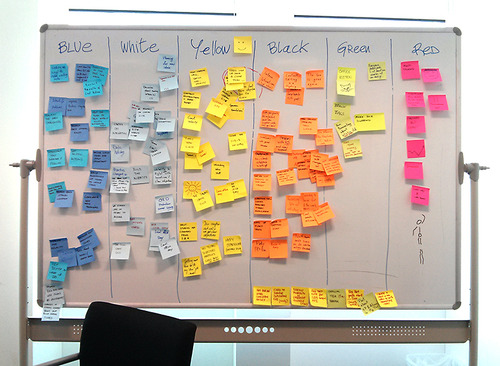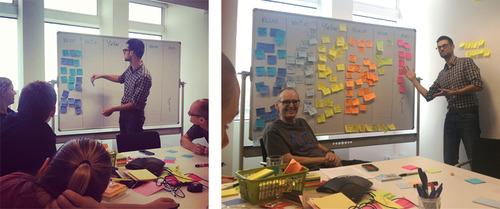Using 6 thinking hats technique for retro
Here in my Thoughtworks project we wanted to try a new retrospective technique — just to give a little twist and stop things going stale.
So we decided to give a try and use the Six thinking Hats technique applied to retrospectives. The Six Thinking Hats - Wikipedia is a general-purpose technique for group discussion that helps the group to think in the same way during different stages, so it looks perfect for a retro :-)
I was the facilitator in this session, and grabbed some information from different sources to create my own tailored Six Thinking Hats session for my team. I used a whiteboard divided into six columns to represent the different hats states (view image)
The session went through the following steps:
- First of all, safety check and prime directive.
- Blue Hat, Thinking the thinking — Use the blue hat to discuss the objectives for the session. Sometimes people forget why do we have retros, or there are new goals or objectives people want to achieve (a kind of meta-hat)
- White Hat, Neutral Information — Participants raise and discuss anything from the last iteration which can be said to be a fact or information. No feelings, only facts that happened.
- Yellow Hat, Positive thinking — Good vibrations! people can only talk about the good things that happened in the last iteration.
- Black Hat, Risks, Threats, Potential problems — Fear! participants can only talk about the bad things that happened, criticism they have or worst case scenarios they can think of. This stage includes talking about the most important themes that appear, and should lead to some actions.
- Green Hat, Creative thinking — let the people go creative and list new ideas about how to solve risks, how to improve the whole workflow or how to get more positive stuff. This step should lead also to some talk and actions.
- Red Hat, Emotions and Feelings — We used this hat to let people communicate their feelings. Anything is admitted, and we encourage people to write a couple of sentences or make a draw. This statements should be instinctive, so you’d better allow just a couple of minutes.

What about timing? To be honest, as this was the first time we run out of time :-(, so this session took more than 60 minutes. This was the timetable we had:
00 — blue hat — explain and make people write
03 — blue hat — categorize and read out loud
05 — white hat — explain and ask people to write
12 — white hat — categorize and read out loud
15 — yellow hat — explain and make people write
18 — yellow hat — categorize and read out loud
20 — yellow hat — talk
25 — black hat — explain and make people write
30 — black hat — categorize and read out loud
32 — black hat — talk + actions
45 — green hat — explain and make people write
48 — green hat — categorize and read
48 — green hat — talk + actions
55 — red hat — explain and ask people write
57 — red hat — read them
60 — finish!
Tips and tricks:
- Timecop! as there is so many steps, you should be very strict with the time.
- Don’t forget the actions! — the whole conversation should lead to actions, and there should appear more actions around the black and green steps.
- Try to keep the conversation inside every specific mood — positive, negative, creative… etc
The feedback was very positive: people wrote more stickies than in other retros and they were also more motivated and focused during the session.
Cheers!

I used the following links: